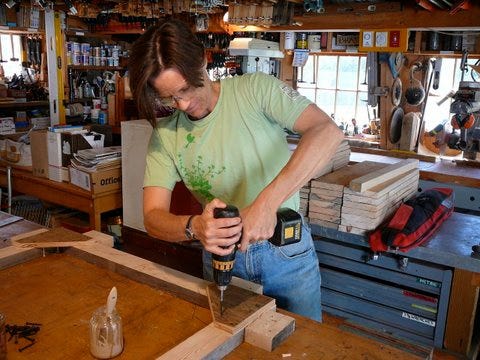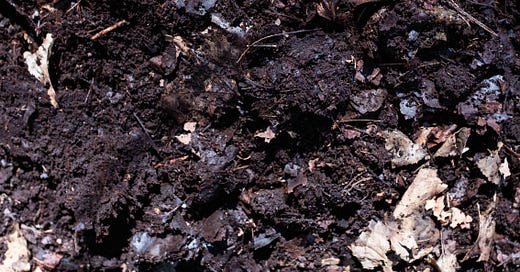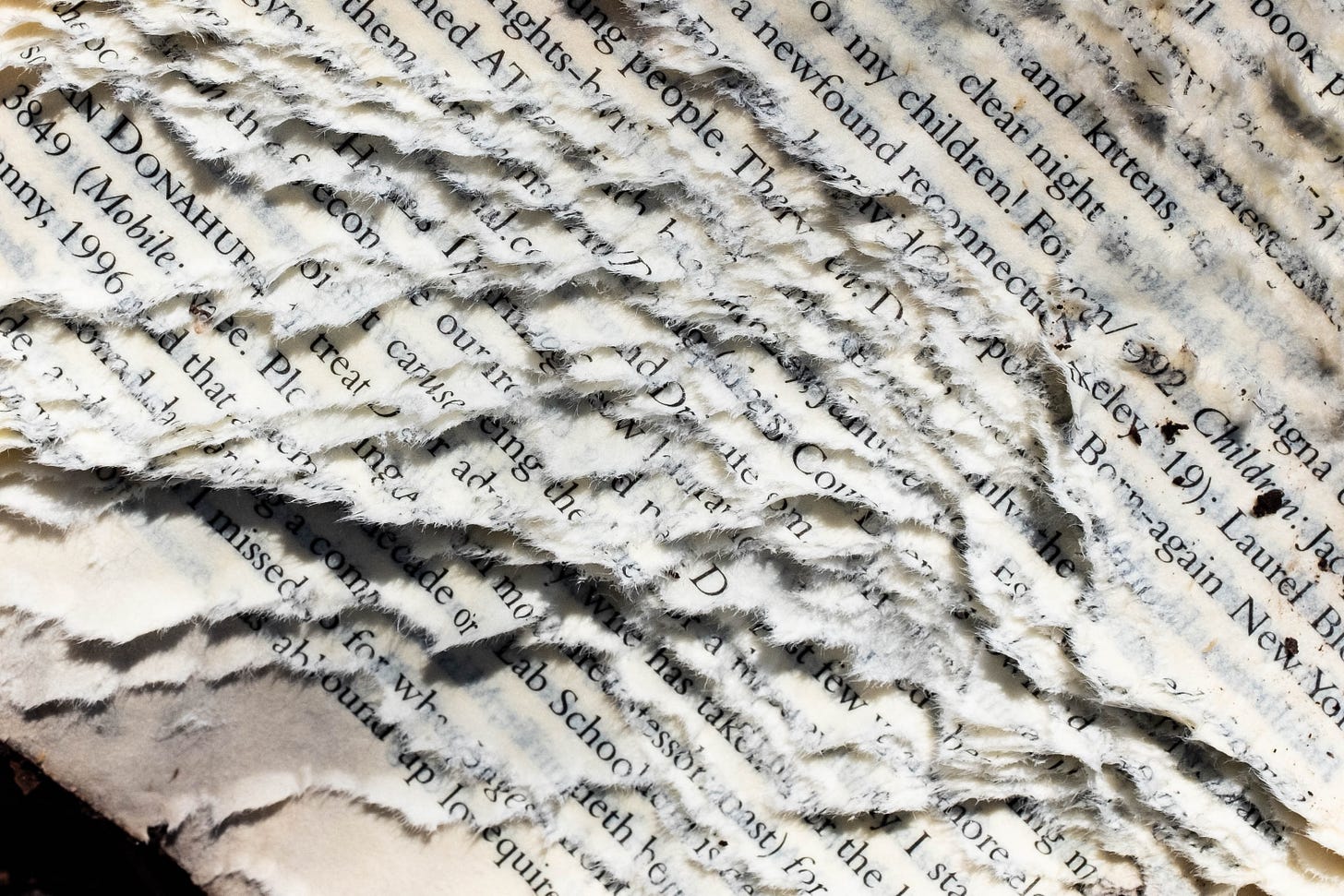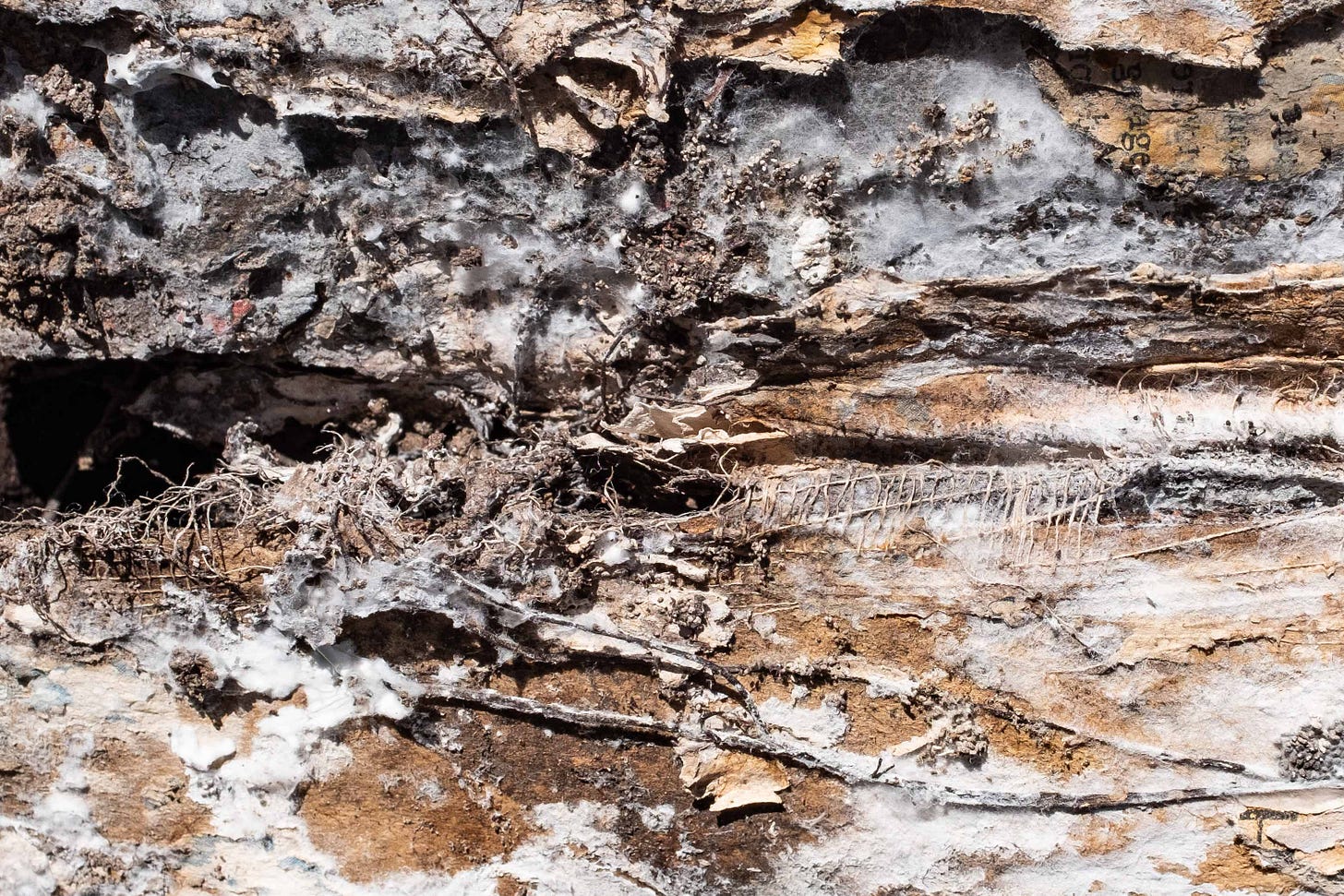The final load of leaf mold fell easily from the wheelbarrow. When I spread this life-giving matter over the last of the books, I inhaled the intoxicating scent of spring, said a prayer to the creatures thriving beneath me, and then walked back to the house.1
It’s done.
The composter is decommissioned.
The last of the Garden Library books are buried.
My 15 year experiment with creatively addressing the climate crisis at our suburban home is over.
Or, is this actually the beginning?
In many ways, Monday was just another day in the garden: A few wheelbarrow loads of compost and a few wheelbarrow loads of leaf mold into another garden bed.2
But this is no ordinary garden. It’s my Garden Library - - a living laboratory where groups of books slowly decomposed between logs, offering stage ‘sets’ for ephemeral fungi and meandering mold.
It’s a place where, for eight years I’ve layered compost, garden detritus, rotting logs and Adirondack chairs, college essays, leaves and decomposing books.



And now H.W. Janson’s History of Art, re-imagined with meandering mold, lies beneath it all, as does my Harvard Class of 1988 35th Reunion Red Book.3 The last ‘batch.’
Am I trying to prove some point or make a grand statement about knowledge, authority and power? Perhaps. You can read into this what you will.
But really this is just a place where I play.
Our entire 1.75 acre lot has been my playground and stage for two decades. The players include trees, shrubs, perennials, herbs and vegetables, and lots of compost; The scene is set by a protective split rail fence and a hand made three bin composter.
The narrative arc involves tension between 20th century habits and aesthetics and 21st century realities. Solar panels are not blights on the landscape, but works of modern art;4 Garden beds that co-opt lawn are not untidy spaces to be managed, but are instead invitations for biodiversity; The compost bin is not a smelly mess, but is the setting for powerful transformations and ongoing renewal.



And on Monday, which was Earth Day, I ‘closed shop’ by documenting the stunning shapes and textures of rotting boards before folding the collapsing composter in on itself, getting it ready for the landfill.5


It seems hard to believe that it’s been fifteen years since I worked with a ‘homesteading’ coach to build my 3 bin composter. Longing for a self-sufficient lifestyle, composting went hand-in-hand with everything else we were trying to accomplish.
Looking back, though, this entire adventure, which now feels like performance art, was a passion project, in which I walked hundreds of miles, alone, hauling loads of soil, compost, mulch, wood chips and plants throughout our yard.
Along the way, my need to ‘do it myself’ resulted in multiple surgeries for hand injuries (trigger finger and carpal tunnel) and physical therapy for on-going knee irritation.
The myth of self-sufficiency feels like just that - - a myth. Plants need each other to thrive; animals need each other to survive; and we need each other for the all of it.
Why has it taken me so long to internalize this reality?
Fifteen years ago, when our house was filled with a growing family with all manner of activities, I longed for the quiet gardening offered. Everything I did came from a place of love, 13+ tons of it, in fact, but it was done in isolation.6
I’m tired of being alone in my garden, even in the company of plants. And now that our house is quiet, I long for something else…a place where I can be in community with others, even when at home.
So on Monday, when I tore apart those final reference books to speed decomposition, I felt relief and deep peace. It was like the earth was welcoming me. My narrative, layered, mixed and mingled with those many stories described in all those books, now re-imagined by the earth herself.
It reminded me of spreading compost on my mother’s grave a year after she died, making sure the soil that surrounded her was well-nourished, because, in fact, just as humans call each other kin, we and the earth are kin too.
Perhaps this is what this land and this garden has been inviting me to understand…
the deep power of collaborative play.
As engaged as I may have been with community committee work and ecological garden creation, it all felt so serious - - I mean, it’s hard to laugh when the planet is approaching unrecoverable tipping points and you’re trying to do all in your power to make a difference.
But without humor and joy, how can any of us be sustained for the long haul?
And that, my friends, is where compost and decomposing books come in. While initially my playmates in the garden, they were also my invitations to join a larger creative community around my photography. How cool is that?
…Speaking of Community:
This Thursday, April 25 some of my Compost: Muse & Metaphor images and some of my Meandering Mold images will be the backdrop to various artists performing in the National Sawdust+ production: Compost! in Brooklyn, NY.
And this Saturday, April 27, two of my winter compost images will be available as part of the AVA Gallery & Art Center’s annual auction. This year’s title for the event is Illumination. Bidding closes at 8:30pm!
And how wondrous to share my delight in decomposing matter with you?
Could it be that my work and my life are becoming more like these moldy webs and book bindings - - seemingly messy, but completely connected and resilient?
Who knew that a desire to learn how to use power tools would result in a decade’s long relationship with decomposing matter?
Who knew that what I learned about form, texture and perspective in H.W. Janson’s History of Art would become integral to the way I make kin with the world around me and that his tome would then become the subject of my explorations?7
Wood decomposes; Food decomposes; Ideas decompose; We decompose.
It’s a gloriously messy and stunningly beautiful process.
Thank you, Earth Day, for providing a framework and focus for action.
While I have issues with the commercialization of these ‘special days,’ this last Monday happened to be the just right moment to say goodbye to the Composter, to the books in the Garden Library and to that part of myself needing to be ‘self-sufficent’ at the expense of deep kinship.
Not done at all, really. This is just the beginning.
Happy Earth Day, Week, Month, Year and Life, my friends.
Thank you for sharing your time and this space with me.
With cheers and gratitude for you being you,
Lyn
Leaf Mold is the compost created by shaded deciduous leaves primarily by fungal breakdown in a slower, cooler manner. I made my leaf mold pile in an old raised bed and piled the annual fall leaf ‘fall’ into it for three years…What I uncovered this week was the result of that pile of maple leaves hanging out for all that time. Last year it was topped off by our lawn person dumping a mix of chopped grass and leaves on top of it all. Pretty cool.
This is the raised bed I mention in Footnote #1.
I’ve written about The Red Book before. Janson’s History of Art, however, has an interesting story. It was the official textbook for the Art History survey course, Fine Arts 13 A & B that both my parents took in the 1950’s and that I took in the 1980’s. While we all enjoyed socializing with our neighbors, Janson’s tome had not been published in my parent’s day.
Many who studied art history in the 70’s or 80’s, however, knew all about this classic. This became particularly clear when a group at my recent opening for my Meandering Mold exhibition in Gallery 3 @AVA Gallery started a heated discussion about the role that book and their art history class played in their lives. 80% of those present who had studied with it, still had Janson’s History of Art on their shelves…or on the wall of a gallery covered in mold.
Solar panels were not included in the chapters on modern art in H.W. Janson’s History of Art. They weren’t really a thing in 1960.
I’d love to bury the composter here as well, but rusty screws and wire would not work in the garden, especially when a young family is about to move in!
Most homesteads are family affairs where everyone participates. As a child, my parents forced us to help maintain the garden and the woods and the fields around our house, but we certainly didn’t live on a homestead and certainly didn’t depend on the land for our lives. It turns out my parenting in response to how I was parented resulted in doing a lot of stuff by myself.
It’s interesting, these multi-generational experiences and the choices we make as a result of our own experiences.
When I look back, I realize that when I deconstructed my Harvard and University of Virginia diplomas and put them into the compost pile, I felt an exhilarated rush that comes from complete engagement, curiosity and creative bliss. Until then, I’d felt like I was ‘faking it till I made it’ and although it took me another year or so to feel like I was truly on the right path, that moment was pivotal to my creative development.
Just a few weeks ago, when I opened Janson’s History of Art and saw the mysterious shapes and forms it contained after living in the garden for two years (Borderlands), I felt that rush again. I wonder why more people don’t try to re-frame what they know and re-imagine what might be? It truly is intoxicating.



























I love the way you describe the play in your work, and the journey that you've been through over the past 15 years. Thanks for sharing this!
Can’t really put into words how reading this affected me…I lived through all that, too. Thank you.